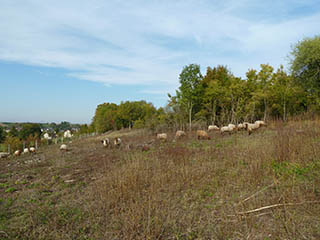Prochain point : lat="49.026363" lon="1.894864"

Eco-grazing
The dry grasslands, a natural heritage to be preserved
A reservoir of biodiversity...
The dry grasslands are not very fertile and the vegetation growing on them is fairly short since the grasslands are located on thin calcareous soil, which is poor in nutrients and water. The upright brome and the heath false brome, the two main grasses found here, grow alongside numerous other flowering plants, some of which have sub-Mediterranean affinities (oregano, thyme and savory). Many wild orchid species also grow in this environment. Thanks to the extremely varied plant life and the hot micro-climate found in these spaces, a vast array of animals thrive here, including butterflies, bumblebees, crickets, reptiles and birds. As a result, the patrimonial and ecological value of these spaces is immense and it is essential that they be preserved.
...Maintained by sheep
Traditionally maintained by extensive sheep grazing, recent developments in farming have led to the massive loss of these dry grasslands across Europe (ploughing, planting, the decline of pastoralism, the land becoming overgrown, backfill...). It is estimated that around 50% of France's dry grassland disappeared in the space of a single century. And the fauna and flora associated with these habitats were not spared.
In 2015, conscious of the value of this natural heritage, the commune of Gaillon-sur-Montcient began promoting the practice of grazing on this site, in the same way as it used to be done in bygone times. The aim of this measure is to help prevent overgrowing, making it possible for plants and animals to survive here.





